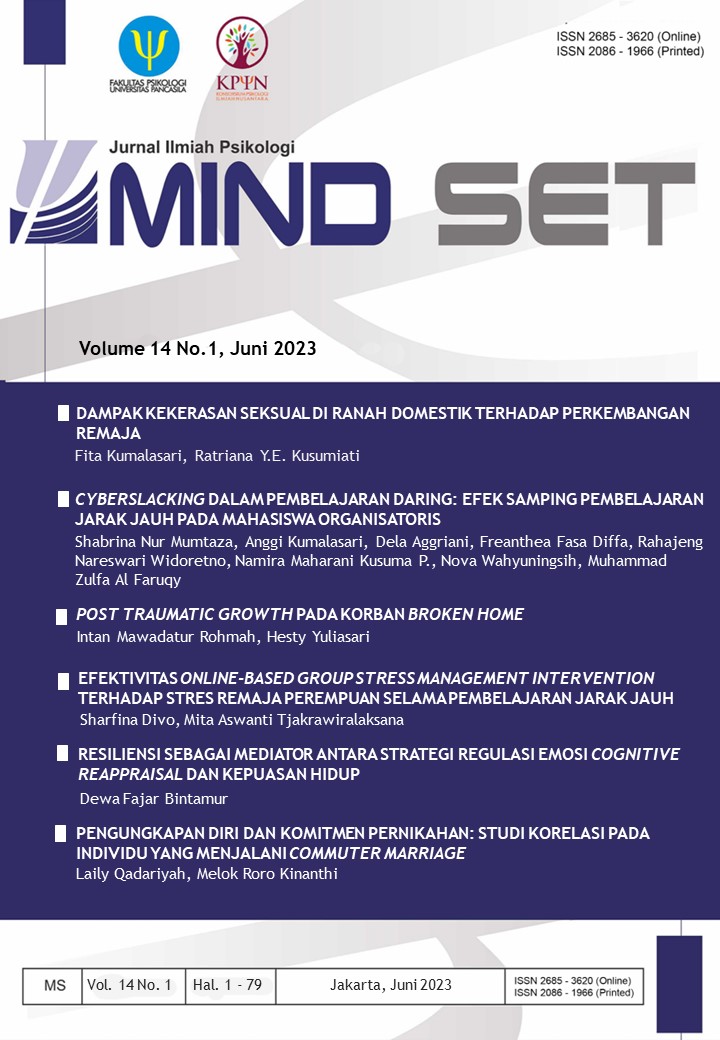Pengungkapan Diri dan Komitmen Pernikahan: Studi Korelasi pada Individu yang Menjalani Commuter Marriage
DOI:
https://doi.org/10.35814/mindset.v14i01.2756Keywords:
commuter marriage, marital commitment, self-disclosureAbstract
Commuter marriages face challenges that can affect the commitment of the couple. One of the main concerns in commuter marriages is communication, particularly how individuals can express their needs, thoughts, and feelings to their partners. This research aims to understand the correlation between self-disclosure and marital commitment among individuals in commuter marriages. The research was conducted using a quantitative approach, with a sample of 100 participants selected through convenience sampling. The research variables were measured using The Eight Dimensions of Self-Disclosure for self-disclosure and the Marital Commitment Inventory for marital commitment. The results of the Pearson correlation test showed a significant correlation between self-disclosure and types of marital commitment among individuals in commuter marriages (r = 0.432-0.462; p = 0.000). These findings indicate that efforts to improve the quantity and quality of communication between spouses, especially in expressing personal needs, expectations, feelings, and thoughts, can be made to maintain marital commitment in commuter marriages.
References
Asmarina, N.L.P.G.M., & Lestari, M.D. (2017). Gambaran kepercayaan, komitmen pernikahan, dan kepuasan hubungan seksual pada istri dengan suami yang bekerja di kapal pesiar. Jurnal Psikologi Udayana, 4(2), 239-249.
Billeter, C. B. (2002). An exploration of eight dimensions of self disclosure with relationship satisfaction. Tesis. Virginia Polytechnic Institute and State University, Blacsburg, Virginia.
Birnie, C., McClure, J., Lydon, J, E., Holmberg, D. (2009). Attachment avoidance and commitment aversion: A script for relationship failure. Personal Relationships, 16, 79–97.
Bojmel, L.B., & Shahar, G. (2011). Emotional and interpersonal consequences of self disclosure in alived, online interaction. Journal of Social and Clinical Psychology, 30(7), 732-759.
Farber, B. A. & Sohn, A. E. (2007). Pattern of self-disclosure in psychotherapy and marriage. Psychotherapy: Theory, Research, Practice, Training, 44(2), 226–231.
Eyo, U. (2018). Divorce: Causes and effects on children. Asian Journal of Humanities and Social Studies, 6(5), 172-177.
Fard, M., Kavoosi, M., Ebadi, Z., & Mousavi, S. (2016). The relationship between self efficacy and marital satisfaction among married students. Int J Pediats, 4(8), 3315-3321.
Gildersleeve, S., Singer, J.A., Skerrett., & Wein, S. (2016). Coding “we-ness” in couples’s relationship stories: A method for assessing mutuality in couple therapy. Psychotherapy Research, 27(3), 313-325.
Gerstel, N., & Gross, H. (1982). Commuter marriage. Marriage and Family Review, 52, 71-93.
Givertz, M., & Segrin, C. (2005). Explaining personal and constraint commitment in close relationships: The role of satisfaction, conflict responses, and relational bond. Journal of Social and Personal Relationships, 22(6), 757-775.
Glotzer, R., & Federlein, A., C. (2007). Miles that bind: Commuter marriage and family strengths. Michigan Family Review, 12, 7-31.
Impett, E. A., Beals, K. P., & Pepalu, L. A. (2001). Testing the investment model, of relationship commitment and stability in a longitudinal study of married couples. Current Psychology, 20(4), 312–326.
Johnson, M.P., Caughlin, J., & Houston, T.L. (1999). The tripartite nature of marital commitment: personal, moral, and structural reason to stay. Journal of Marriage and Family, 61, 160-177.
Jourard, S. M. (1971). Self-disclosure: an experimental analysis of the transparent self. London: Wiley.
Kinanthi, M.R. (2018). Faktor penentu komitmen pernikahan pada kelompok populasi tahap pernikahan transition to parenthood hingga family with teenagers. Psikodimensia, 17(1), 63-76.
Latifatunnikmah., & Lestari, Sri. (2017). Komitmen pernikahan pada pasangan suami istri bekerja. Humanitas, 14(2), 103 – 119.
Laurenceau, J.P., Barret, L.F., & Pietromonaco, P.R. (1998). Intimacy as an interpersonal process: The importance of self-disclosure, partner disclosure, and perceive partner responsiveness in interpersonal exchanges. Journal of Personality and Social Psychology, 74, 1238-1251.
Layinah, S.F. (2016). Gambaran gaya Resolusi konflik pada pasangan commuter marriage di Kecamatan Cisarua Kabupaten Sumedang. Skripsi, tidak diterbitkan. Universitas Islam Bandung, Bandung.
Lee, J. (2016). Self disclosure and relational outcomes: The context-dependent disclosure intimacy satisfaction model. Disertasi. University of Kansas, Amerika Serikat.
Litiloly, F., & Swastiningsih, N. (2014). Manajemen stres pada istri yang mengalami long distance marriage. Empathy, 2(2), 53-61.
Nelson, J.A., Kirk, A.M., Ane, P., & Serres, S.A (2011). Religious and spiritualitas values and moral commitment in marriage: Untapped resources in couples counseling? Counseling and Values, 55(2), 228-246.
Maharani, F., & Kinanthi, M.R. (2018).Peran komitmen pernikahan tipe personal dedication terhadap kepuasan pernikahan pada individu yang menjalani commuter marriage. INSIGHT, 14(1), 15-36.
Ningrum, A. (2017). Keterbukaan diri dalam strategi konflik pada pasangan intercultural marriages. Skripsi, tidak diterbitkan. Universitas Muhammadiyah Surakarta, Surakarta.
Nisfiannoor, M. (2009). Pendekatan statistik modern. Jakarta : Salemba Humanika.
Nuraini, F.D., & Masykur, A.M. (2015). Gambaran dinamika psikologis pada istri pelaut. Emphathy, 41(1), 82-87.
Pameswara, A. D. & Sakti, H. (2016). Pernikahan jarak jauh (studi kualitatif fenomenologis pada istri yang menjalani pernikahan jarak jauh). Jurnal Empati, 5(3), 417-423.
Prianto, B., Wulandari, N. & Rahmawati, A. (2013). Rendahnya komitmen dalam perkawinan sebagai sebab perceraian. Jurnal Komunitas, 5(2), 208-218.
Putri, O., & Ajisuksmo, C. (2017). Deskripsi intimacy, passion, dan commitment pasangan suami istri yang menikah secara Katolik. Jurnal Muara Ilmu Sosial, Humaniora, Seni, 1(2), 170-183.
Quek, K.M.T., & Fritzpatick, J. (2013). Cultural values, self disclosure, and conflict tactics as predictors of marital satisfactionamong Singaporean husband and wives. The Family Journal, 21(2), 208-216.
Quek, K.M.T., Taniguchi, N., & Argiropoulou, M.I. (2015). Self disclosure between marital couple: A comparative study between Singapore and Greek. Journal of Comparative Family Studie, XLVI(2), 221-240.
Rokach, A. & Philibert-Lignieres, G. (2015). Intimacy, loneliness & infidelity. The Open Psychology Journal, 8, 71-77.
Rusbult, C.E., Martz, J.M., & Agnew, C.R. (1998). The investment model scale: Measuring commitment level, satisfaction level, quality of alternatives, and investment size. Personal Relationship, 5, 357-391.
Sakinah, F. & Kinanthi, M. R. (2018). Pengungkapan diri dan kepuasan pernikahan pada individu yang menikah melalui proses ta’aruf. Jurnal Psikologi Integratif, 6(1), 29-49.
Sandow, E. (2014). Till work do us part: The social fallacy of long-distance commuting. Urban Studies Journal Limited, 51(3), 526-543.
Stanley, S.M., Markman, H.J., & Whitton, S.W. (2002). Communication, conflict, and commitment: Insight on the foundations of relationship success from a national survey. Family Process, 41, 659-675.
Stanley, S.M., & Markman, H.J. (1992). Assesing commitment in personal relationship. Journal of Marriage and Family, 54, 595-607.
Sprecher, S., Treger, S., & Wondra, J.W. (2012). Effects of self disclosure role on liking, closeness, and other impression in get-acquainted interactions. Journal of Social and Personal Relationship, 30(4), 497-514.
Swadiana, S.R. (2014). Penyesuaian perkawinan pada istri yang menjalani commuter marriage. Bandung: Universitas Pendidikan Indonesia. Skripsi Tidak Diterbitkan.
Sprecher, S., & Hendrick, S.S. (2004). Self disclosure in intimate relationship: Association with individual and relationship characteristic over time. Journal of Social and Clinical Psychology, 23(6), 857-877.
Tahmasebi, M.T., & Ahmadi, E. (2015). The relationship between marital conflict and marital commitment of married couples in Ayatollah Amoli Azad University. International Journal of Humanities and Cultural Studies, 2(3), 1065-1075.
Utami, S. (2018). Komitmen dan kepuasan pernikahan pada pasutri dengan rentang usia jauh di Samarinda. Psikoborneo, 6(2), 351-358.
Waring, J. A. (2001). The marital self-disclosure questionnaire: A validation study. Tesis. The University of British Columbia, Vancouver, Kanada.
Weigle, D. J, Bennett, K. K, & Ballard-Reisch, D. S. (2006). Roles and influence in Marriages: Both spouses’ perceptions contribute to marital commitment. Family and Consumer Sciences Research Journal, 35(1), 74-92.
Wieselquist, J. (2009). Interpersonal forgiveness, trust, and the investment model of commitment. Journal of Social and Personal Relationship, 26(4), 531-548.
Wulandari, D.A. (2014). Komitmen pada perkawinan ditinjau dari kepuasan dalam perkawinan. Dipresentasikan pada Seminar Hasil Penelitian LPPM UMP di Purwokerto, Jawa Tengah.
Wulandari, D.A., & Septiningsih, D.S. (2015). Komitmen pada perkawinan. Prosiding Seminar Nasional Penelitian dan PKM Kesehatan, 1(1), 161-165.
Yulianti, A. (2015). Emosional distres dan kepercayaan terhadap pasangan yang menjalani commuter marriage. Dipresentasikan pada Seminar Psikologi dan Kemanusiaan UMM di Malang, Jawa Timur.










